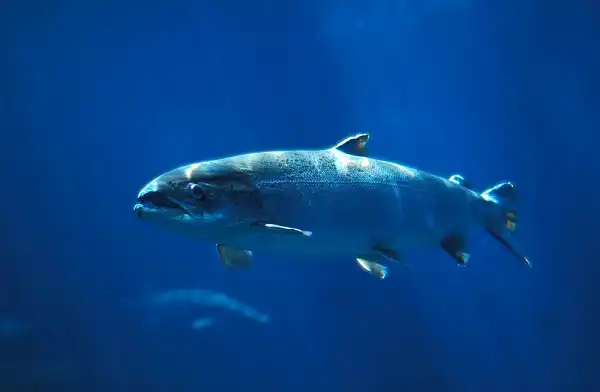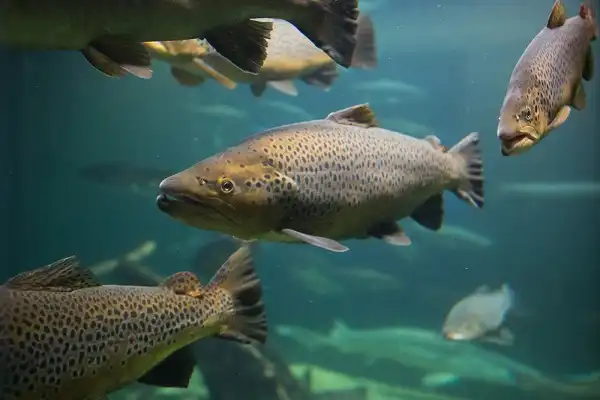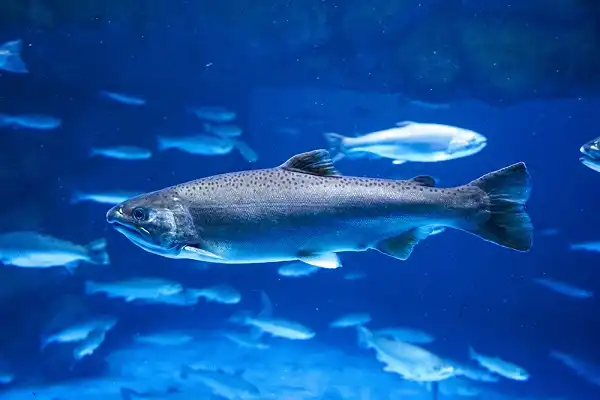Imagine a creature so extraordinary that you can’t help but marvel at its majestic beauty – the salmon. These sea creatures are renowned for their graceful movements, and amazing endurance as they navigate vast distances of up to 3000 miles in order to return to their birth streams where they spawned. Not only that, but these fish have evolved over hundreds of thousands of years allowing them unique survival mechanisms and making them one of nature’s most amazing creatures! But what is it about the salmon that makes it so impressive? In this blog post, we will explore everything there is to know about these resilient fish – from their miraculous migrations, fascinating habitats, clever navigation techniques, and why they are such an important part of our natural environment. So come along with us on an adventure through the wonders of the Salmon world!

Salmon Description
Salmon are a species of fish that have multiple physical characteristics that make them stand out from the rest. They have an elongated body shape, with streamlined heads and tapered tails that help them navigate through the water with ease. Their scales are usually gray or silvery in color, allowing them to blend in with their aquatic environment. They also have two sets of fins; pectoral fins which are used for steering, and caudal fins which provide thrust when swimming. This is because they need to sustain themselves while they make their long migrations back to their spawning grounds. Throughout these journeys, salmon must be able to survive powerful currents, extreme temperatures, and swift predators. To do this, they have developed strong muscles and sleek bodies which allow them to propel themselves against powerful winds and swiftly maneuver around obstacles. Furthermore, salmons’ thick layer of slime helps protect them against predators and parasites in the water.
Salmon Habitat
Salmon are found in a variety of habitats, ranging from freshwater streams and rivers to estuarine habitats and even the ocean. They are generally found in areas with cool, clear water, usually preferring temperatures between 6-12°C. Salmon typically spawn in shallow gravel beds where they lay their eggs and guard them until hatchling. The young salmon then make their way downstream, where they remain for 1-3 years before beginning their long journey back upstream toward the spawning grounds. In addition to these freshwater bodies of water, some species of salmon will migrate out to the ocean where they can live for up to several years before returning to their birth stream. During this time, they search for food sources such as small crustaceans and fish which provide them with the necessary sustenance for their long-distance migration. Salmon also have an incredible ability to adapt to different habitats over time – some species are able to migrate between saltwater and freshwater habitats depending on the availability of food sources. This adaptation enables them to survive in a range of environments that would otherwise be too extreme or inhospitable for other species of fish. As climate change continues to affect our planet’s ecosystems, this attribute could prove invaluable in helping protect our fragile salmon population from extinction.
Salmon Diet
Salmon are incredibly versatile eaters, consuming a wide variety of food sources from both freshwater and saltwater habitats. In freshwater bodies, they feed on aquatic insects such as mayflies, caddisflies, stoneflies, and midges. They also feed on small crustaceans such as amphipods and copepods, as well as other smaller fish that inhabit the same waters. In saltwater habitats, salmon will feed on a range of small to medium-sized fish such as herring, smelt, capelin, mackerel, and sand lance. They also consume crustaceans such as shrimp and squid which provide them with additional nutrition. In addition to these animal-based sources of nutrients, salmon will also consume some plant material such as algae. To meet their nutritional needs while in the ocean, salmon must consume large amounts of food; up to 10% of their body weight every day! This is why it is essential for them to find rich sources of food in order to survive during their long migratory journeys. By eating a diverse diet that includes both animal-based prey and plant matter, salmon can ensure that they have all the necessary nutrients needed for a successful migration back home!

Salmon Size
Salmon can range in size from as small as 4 inches to as large as 60 inches, with an average size of 12-24 inches. Male salmon tend to be larger than female salmon and can reach weights of up to 45 pounds. The largest species of Pacific Salmon, the Chinook (Oncorhynchus tshawytscha), is capable of reaching lengths of more than 40 inches and weights of over 100 pounds. Interestingly, the size of a salmon is not limited by its age but rather by the type of environment it lives in – for example, ocean-dwelling species like chinook are much larger than their river-dwelling counterparts due to the abundance and variety of food sources available in the ocean. Salmon are also able to rapidly increase their size when they return from the ocean back into freshwater rivers or streams. This process, known as smoltification or osmotic acclimation, enables them to quickly adjust their metabolism and physiology for life in freshwater environments in order to make rapid growth possible. During this time period, salmon will double or even triple in size!
Salmon Lifespan
The lifespan of salmon varies greatly depending on the species and can range from 1 to 8 years. On average, most Pacific salmon will have a life span of three to four years. Chinook salmon, the largest species of Pacific salmon, typically have a lifespan of 4 to 7 years. The longest recorded lifespan for any species of salmon is 8 years, which is held by Atlantic salmon (Salmo Salar). During their lifetime, salmon will complete several migrations throughout its lifetime in order to spawn and reproduce. Salmon will travel long distances in order to reach their spawning grounds – some species travel over 3,000 miles! During this journey, they must also battle against predators and various environmental stresses such as changes in water temperature or acidity.
The first migration is usually completed by the juvenile fish as they migrate from their natal stream into the ocean. This migration can be incredibly taxing on the young fish as they are not yet adapted for life in saltwater environments – many do not survive this transition due to predation or other environmental stresses. If they do make it through, however, the fish can then spend up to 2 or 3 years living and feeding in the open ocean before returning back home via the same migratory route that they set out on when they were juveniles.
Salmon Behavior
Salmon have an array of behaviors that allow them to successfully migrate, breed, and survive in their environment. During migration, salmon use a combination of instinctive behavior as well as learned behaviors to navigate long distances back into their natal streams in order to spawn. They also have excellent homing abilities which enable them to remember their exact home waters even after years of residency in the ocean. In addition, salmon use specific behaviors such as leapfrogging or porpoising (leaping out of the water) when moving upstream in order to maximize propulsion and overcome obstacles like waterfalls.
While spawning, male salmon may become more aggressive and territorial – depending on the species they may begin chasing away other males or actively competing with them for access to spawning females. Finally, many species of salmon also engage in ‘respawning’ behavior which involves congregating at the mouth of rivers close to their natal stream before making the journey upstream. This allows for group protection against predators and increases their chances of successful reproduction once they reach suitable spawning grounds.

Salmon Speed
Salmon are capable of swimming at an impressive speed with some species able to reach speeds up to 60km/h in short bursts! However, the majority of salmon will swim at a more leisurely pace of around 10-20kph and can maintain this speed for extended periods of time. The reason they are able to swim so fast is due to their unique body shape which is designed for maximum efficiency in water. Their streamlined profile, paired with powerful tail flukes, allows them to cut through the water with minimal effort and resistance. As well, salmon have an incredible amount of stamina which enables them to make long migrations and sustain themselves on their journey.
Salmon Hunting
Salmon are an important resource for many regions worldwide, and their hunting is a tradition passed down through generations. The methods used to hunt salmon vary greatly depending on the region and the species being targeted. In some areas, angling or sport fishing is the most prevalent form of salmon hunting. This involves using specialized lures or bait to entice a salmon to bite onto a hook which is then reeled in by the angler. In other areas, spearing is used to harvest salmon. It involves using a long pole with an attached spearhead to impale and capture salmon as they swim past. This method is often employed by indigenous communities who rely on subsistence fishing in order to provide for their families. On the Pacific Coast of North America, Native Americans have employed various techniques such as gillnetting, fish weirs, and dip-netting in order to efficiently capture migrating salmon during their runs upriver. These methods involve constructing barriers or nets in rivers that are designed to trap fish as they try to swim upstream toward their spawning grounds. Once captured, these fish can then be harvested for both sustenance and commercial purposes.
Salmon Different Species
Salmon are a diverse species, with many different varieties swimming across the world’s oceans and rivers. The most commonly known types are Pacific salmon which includes Sockeye, Chinook, Coho, Chum, and Pink Salmon. These fish can be found in the North Pacific Ocean along the West Coast of North America and as far south as Japan. Atlantic salmon are also abundant in the cooler waters of the Northern Atlantic Ocean, and some of these fish can be found along the coasts of Maine and New England up to Greenland. Additionally, there are several species that exist only in freshwater such as Brook trout, Rainbow trout, and Steelhead trout which inhabit rivers from Canada to California.
Each species has its own unique adaptations which help them survive in their respective habitats; for example, Pacific salmon have an anadromous life cycle meaning they spawn in freshwater but spend most of their lives in saltwater whereas Atlantic salmon remain completely aquatic throughout their lifespan. They also have different migration patterns with some traveling thousands of kilometers upriver to reach their spawning grounds while others only migrate short distances or not at all. The coloration of these fish also varies from species to species – Pacific salmon tend to have vibrant hues of pink or red whilst Atlantic salmon typically possess silver scales with black spots on their backs and fins. Additionally, they may have a variety of shapes ranging from long slender bodies (Pacific) to shorter stockier forms (Atlantic).

Conclusion
Salmon are fascinating and incredibly important creatures that inhabit a wide range of freshwater and saltwater habitats. There are numerous species of salmon ranging from the iconic Pacific and Atlantic varieties to Brook trout, Rainbow trout, Steelhead trout, and more. These fish have evolved a variety of adaptations that help them survive in their respective environments such as anadromous life cycles, migratory patterns, coloration differences, and various shapes. Additionally, they all share an amazing life cycle where they migrate back to their place of birth to lay eggs before repeating the journey downstream toward oceans around the world.
Frequently Asked Question

